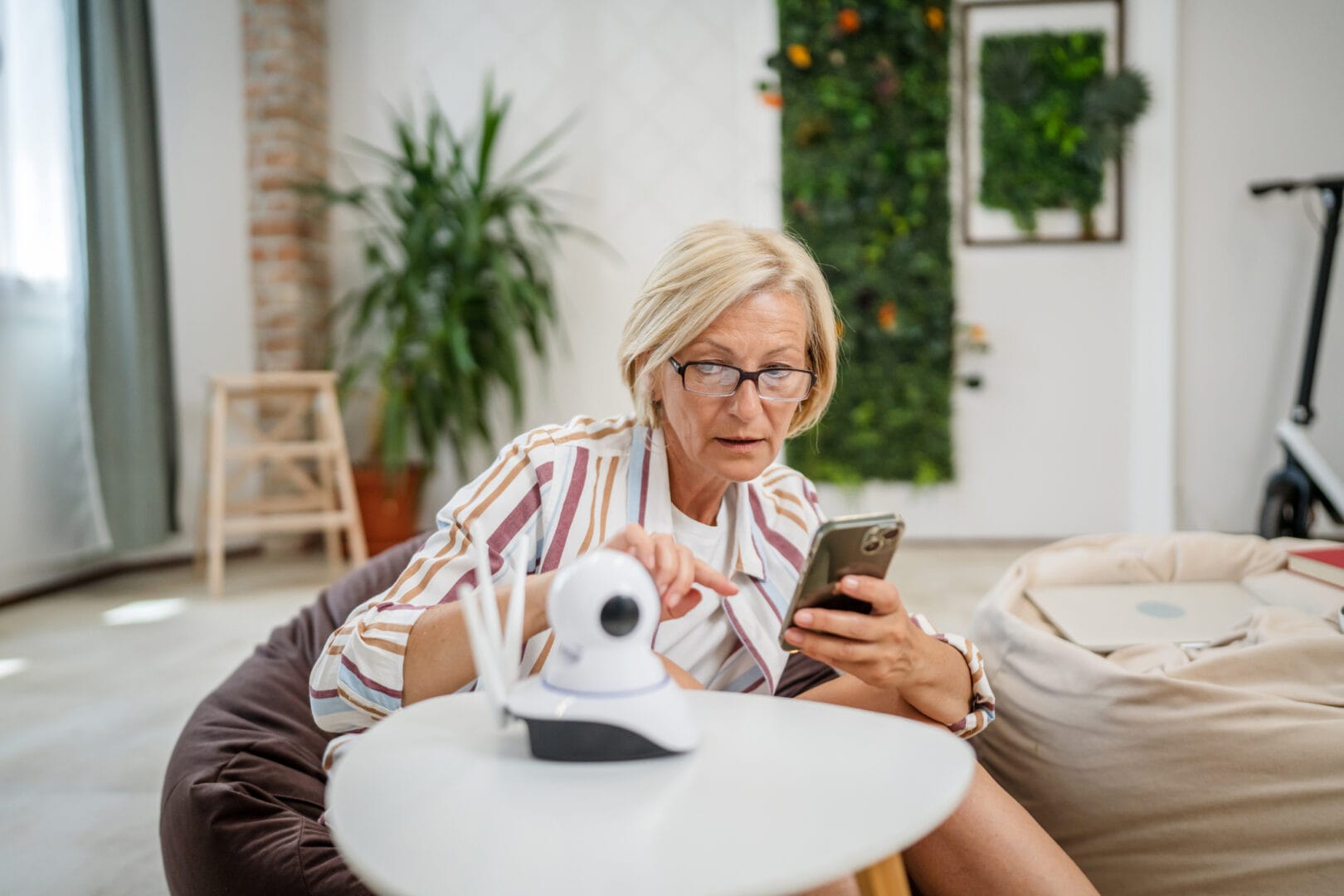As our loved ones gracefully age, there's a heartfelt inclination to cherish their independence in everyday tasks and decision-making. This cherished aspect not only adds to their joy but also profoundly enriches their overall quality of life.
A pioneering strategy to meet the changing needs of seniors has materialized through the introduction of assistive technologies (AT), acting as powerful instruments to enrich the lives of seniors. These technologies are intricately designed to provide essential support, aiding seniors in overcoming the hurdles associated with the graceful process of aging.
The Role of Independence in Seniors Enhanced by Assistive Technologies (AT)
Preserving autonomy among seniors holds paramount importance for various reasons, significantly influencing their overall well-being and quality of life. Here are some key considerations underscoring the importance of independence, particularly when complemented by the integration of assistive technologies:
- Mental Empowerment: Independence cultivates a profound sense of control, positively influencing mental health.
- Emotional Well-being: Performing tasks autonomously elevates self-esteem and fosters a positive life outlook.
- Social Connection through AT: Seniors, empowered by assistive technologies, are more likely to engage socially, maintaining vital connections.
- Enhanced Physical Health: Assistive technologies contribute to improved physical well-being, supporting enhanced mobility and self-care.
- Comprehensive Well-being: The synergistic relationship between independence and assistive technologies collectively shapes seniors' holistic well-being
The Types of Assistive Technologies
Assistive technologies for seniors have evolved significantly in recent years, providing valuable support to family caregivers. These technologies aim to enhance the quality of life for seniors, promote independence, and alleviate the burden on caregivers. Here are some key areas of assistive technologies and their applications for seniors:
Communication and Social Connection
Assistive technologies can help seniors to overcome communication challenges and maintain social connections. There are a number of different assistive technologies available for communication and social connection, including:
- Smartphones and Tablets: These devices can be equipped with apps for video calls, messaging, and social media to help seniors stay connected with family and friends.
- Voice-activated Assistants: Devices like Amazon Echo or Google Home can assist seniors with various tasks, including setting reminders, making calls, and playing music through voice commands.
- Augmentative and alternative communication (AAC) devices: AAC devices can help people who have difficulty communicating to express themselves using symbols, pictures, or electronic speech.
- Speech-to-text software: Speech-to-text software can transcribe spoken words into text, which can be helpful for people who have difficulty speaking.
Health Monitoring
There are a number of different assistive technologies available for health monitoring, including:
- Wearable Devices: Smartwatches and fitness trackers can monitor vital signs, activity levels, and sleep patterns. Some can also send alerts in case of abnormal readings.
- Remote Health Monitoring Systems: These systems use sensors to track health metrics and can alert caregivers or healthcare providers in case of emergencies or changes in health status.
When choosing assistive technologies for health monitoring, it is important to consider the individual needs of the senior. Factors to consider include the senior's health conditions, their lifestyle, and their budget.
It is also important to involve the senior in the decision-making process. The senior should be able to try out different assistive technologies to see which ones they like best.
Medication Management
Medication management is an important aspect of healthcare for seniors, as it can help to ensure that they are taking their medications safely and effectively. This can be challenging for some seniors, as they may have multiple medications to take, or they may have difficulty remembering when to take them. Assistive technologies can help seniors to manage their medications and improve their overall health and well-being.
There are a number of different assistive technologies available for medication management, including:
- Smart Pill Dispensers: These devices dispense medication at scheduled times and send reminders to seniors. Some can also alert caregivers if a dose is missed.
- Medication Reminder Apps: Smartphone apps can send reminders to seniors to take their medications and provide information about each medication.
Additional Resources
- National Council on Aging: https://www.ncoa.org/older-adults/health/physical-health/medication-management
- AARP: https://www.aarp.org/caregiving/health/info-2020/medication-management.html
- Administration for Community Living: https://www.aaos.org/globalassets/quality-and-practice-resources/anterior-cruciate-ligament-injuries/aclcpg.pdf
Home Safety and Security
According to the Centers for Disease Control and Prevention (CDC), falls are the leading cause of injury death among older adults, with over 36,000 deaths occurring each year. Many of these falls happen at home.
There are a number of assistive technologies that can help seniors to stay safe and independent at home. These technologies can range from simple devices, such as medication reminders, to more complex systems, such as home monitoring systems.
Some examples of assistive technologies for home safety and security include:
- Smart Home Devices: Motion sensors, smart doorbells, and smart locks can enhance home security and provide peace of mind to both seniors and caregivers.
- Fall Detection Systems: Wearable devices or sensors placed around the home can detect falls and automatically alert caregivers or emergency services.
GPS Trackers
GPS trackers can be a valuable tool for caregivers of seniors, especially those with dementia or Alzheimer's disease who are prone to wandering. They can provide peace of mind knowing that you can locate your loved one if they become lost or disoriented.
Here are some of the benefits of using GPS trackers for seniors:
- Increased safety: GPS trackers can help to keep seniors safe by alerting caregivers when they wander outside of a designated safe zone.
- Reduced stress: GPS trackers can help to reduce stress for caregivers by providing them with a way to keep track of their loved one's whereabouts.
- Improved quality of life: GPS trackers can help seniors to maintain their independence and quality of life by allowing them to live in their own homes for longer.
The GPS tracker should have the features that you need, such as geofencing, SOS alerts, and activity tracking. GPS trackers can range in price from around $50 to $300.
Cognitive Support
Cognitive support is essential for seniors, and technology offers innovative solutions to maintain mental acuity.
- Memory Aids: Apps and devices that help seniors with memory loss by providing reminders for daily tasks, appointments, and important information.
- Interactive Games: Cognitive games and puzzles on tablets or computers can help maintain mental acuity.
- Environmental modifications: Environmental modifications, such as making sure that things are well-lit and easy to find, can help seniors to stay organized and avoid confusion.
Mobility and Transportation
Mobility and transportation are critical aspects of senior well-being, and technology plays a pivotal role in addressing related challenges.
- Personal Emergency Response Systems (PERS): These wearable devices allow seniors to call for help in case of emergencies, providing a sense of security.
- Transportation Services Apps: Apps that facilitate transportation services, such as ridesharing, to help seniors maintain their independence.
Remote Caregiver Support
Remote caregiver support has evolved significantly with the advent of technology, offering invaluable tools to enhance the caregiving experience.
- Telehealth Services: Virtual healthcare consultations allow caregivers to consult with healthcare professionals without the need for in-person visits.
- Caregiver Apps: Apps that help caregivers coordinate schedules, share information, and communicate with each other to provide better care.
It's important to note that the effectiveness of these technologies depends on the individual needs and preferences of seniors and their caregivers. Additionally, ongoing support, training, and user-friendly interfaces are crucial for the successful adoption of assistive technologies in the senior population.
Overcoming Barriers to Adoption of Assistive Technologies
Introducing and encouraging seniors to use assistive technologies can greatly enhance their quality of life, independence, and overall well-being. However, it's important to approach this process with sensitivity, understanding, and patience. Here are some tips for introducing and encouraging seniors to use assistive technologies:
- Start with an Assessment: Begin by assessing the specific needs and preferences of the senior. Understand their challenges and determine which assistive technologies may be most beneficial.
- Educate and Raise Awareness: Provide clear and simple information about the benefits of assistive technologies. Emphasize how these technologies can enhance their daily lives and maintain independence.
- Demonstrate the Technologies: Offer hands-on demonstrations to showcase how the assistive technologies work. Allow seniors to interact with the devices and experience their potential benefits firsthand.
- Use Familiar Terminology: Use language that is familiar and easy to understand. Avoid technical jargon and provide explanations in a way that resonates with the seniors.
- Highlight Personalization: Emphasize that many assistive technologies can be personalized to suit individual needs. This helps seniors feel a sense of ownership and control over the technology.
- Provide Training and Support: Offer comprehensive training sessions to teach seniors how to use the assistive technologies effectively. Provide ongoing support and assistance as needed.
- Involve Family and Caregivers: Engage family members and caregivers in the process. Their support and understanding can be instrumental in encouraging seniors to embrace assistive technologies.
- Address Concerns and Fears: Acknowledge and address any concerns or fears that seniors may have about using new technologies. Provide reassurance and patiently address their questions.
- Encourage a Gradual Approach: Introduce technologies gradually, allowing seniors to become comfortable with each tool before moving on to the next. This step-by-step approach can build confidence.
- Promote Independence: Emphasize how assistive technologies can promote independence rather than dependence. Seniors often appreciate tools that allow them to maintain control over their lives.
- Stay Patient and Flexible: Be patient and flexible throughout the process. Understand that some seniors may take more time to adapt, and adjustments may be necessary based on their feedback.
- Incorporate Fun and Enjoyment: Make the learning process enjoyable. Incorporate fun activities and positive experiences to create a positive association with the use of assistive technologies.
- Regularly Check-In: Schedule regular check-ins to assess how seniors are adjusting to the technologies. Address any issues promptly and provide ongoing support as needed.
Remember that the key is to approach the introduction of assistive technologies with empathy, respect, and a willingness to adapt to the unique needs of each senior.
A Compassionate Conclusion on Empowering Seniors with Assistive Technologies
In the heartwarming journey of our seniors gracefully aging, maintaining independence emerges as a cornerstone for their holistic well-being. The multifaceted benefits of independence touch upon physical health, mental resilience, social connections, cognitive vitality, and the overall quality of life. Recognizing this, the integration of assistive technologies has become a pioneering strategy, offering not just practical support but also a means to navigate the challenges of aging with grace. From smart home devices to wearable health monitors and communication tools, these technologies play a crucial role in fostering a sense of autonomy, ensuring that our senior loved ones can continue making choices aligned with their preferences and values.
Yet, introducing assistive technologies requires a compassionate and patient approach. Educating seniors, demonstrating the functionalities, involving caregivers, and addressing concerns are essential steps to facilitate a seamless transition. As we navigate this landscape of innovation, let us embrace the potential of assistive technologies to enhance the lives of seniors, celebrating the unique journey of each individual while providing the support needed for them to age with dignity and joy.





